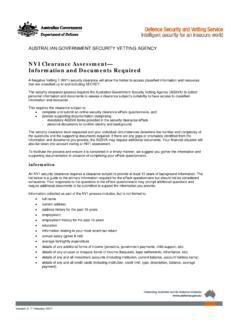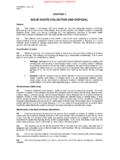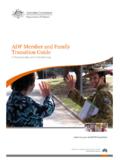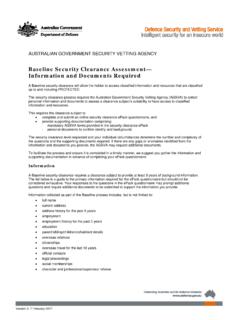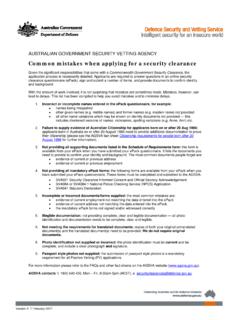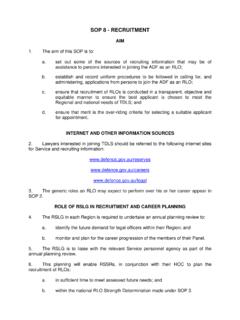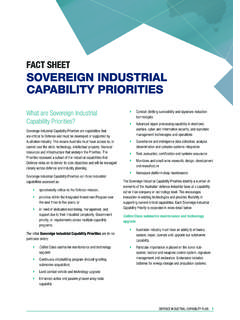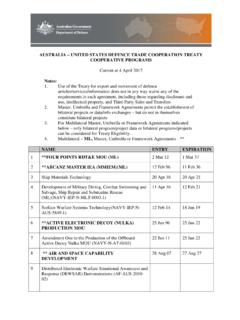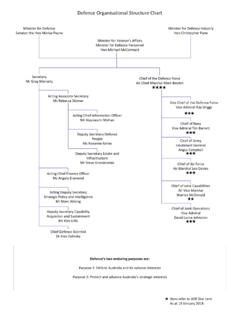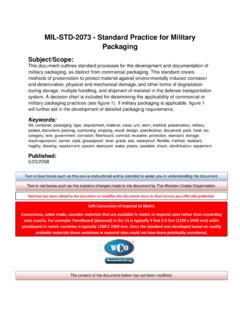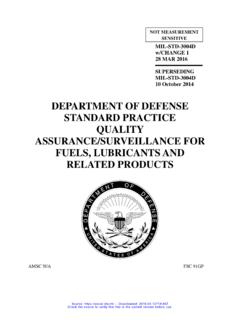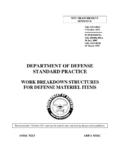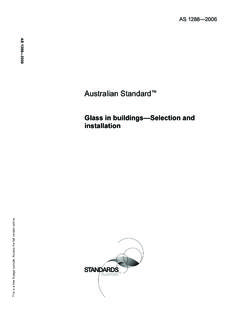Transcription of Australian/New Zealand Standard - Department of …
1 AS/NZS 4187:2003 Australian/New Zealand Standard Cleaning, disinfecting and sterilizing reusable medical and surgical instruments and equipment, and maintenance of associated environments in health care facilities AS/NZS 4187 This is a free 11 page sample. Access the full version online. AS/NZS 4187:2003 This Joint Australian/New Zealand Standard was prepared by Joint Technical Committee HE-023, Processing of Medical and Surgical Instruments and Equipment. It was approved on behalf of the Council of standards Australia on 9 December 2002 and on behalf of the Council of standards New Zealand on 13 December 2002. It was published on 28 January 2003. The following are represented on Committee HE-023: australian Chamber of Commerce and Industry australian College of Operating Room Nurses australian Dental Association australian Dental Industry Association australian General Practice Accreditation Ltd australian Health Care Association australian Health Industry Inc.
2 australian Infection Control Association australian Medical Association australian Nursing Federation Commonwealth Department of Health and Ageing Dental Assistants Association of Australia Department of Defence Department of Human Services, Vic. Federation of Sterilizing Research and Advisory Councils of Australia Gastroenterological Nurses College of Australia Health Department of Western Australia Medical Industry Association of Australia Ministry of Health, New Zealand New Zealand Nurses Organisation New Zealand Sterile Services Association Health Department Queensland Health Royal Australasian College of Surgeons Royal australian College of General Practitioners Rural Doctors Association of Australia South australian Health Commission Additional interests participating in the preparation of this Standard .
3 australian Association of Practice Managers Infection Control Review and Certification Service, Keeping standards up-to-date standards are living documents which reflect progress in science, technology and systems. To maintain their currency, all standards are periodically reviewed, and new editions are published. Between editions, amendments may be issued. standards may also be withdrawn. It is important that readers assure themselves they are using a current Standard , which should include any amendments which may have been published since the Standard was purchased. Detailed information about joint Australian/New Zealand standards can be found by visiting the standards Australia web site at or standards New Zealand web site at and looking up the relevant Standard in the on-line catalogue.
4 Alternatively, both organizations publish an annual printed Catalogue with full details of all current standards . For more frequent listings or notification of revisions, amendments and withdrawals, standards Australia and standards New Zealand offer a number of update options. For information about these services, users should contact their respective national standards organization. We also welcome suggestions for improvement in our standards , and especially encourage readers to notify us immediately of any apparent inaccuracies or ambiguities. Please address your comments to the Chief Executive of either standards Australia International or standards New Zealand at the address shown on the back cover. This Standard was issued in draft form for comment as DR is a free 11 page sample.
5 Access the full version online. A AS/NZS 4187:2003 Australian/New Zealand Standard Cleaning, disinfecting and sterilizing reusable medical and surgical instruments and equipment, and maintenance of associated environments in health care facilities Originated as AS 4187 1994. Previous edition 1998. Jointly revised and designated as AS/NZS 4187:2003. COPYRIGHT standards Australia/ standards New Zealand All rights are reserved. No part of this work may be reproduced or copied in any form or by any means, electronic or mechanical, including photocopying, without the written permission of the publisher. Jointly published by standards Australia International Ltd, GPO Box 5420, Sydney, NSW 2001 and standards New Zealand , Private Bag 2439, Wellington 6020 ISBN 0 7337 5024 9 This is a free 11 page sample.
6 Access the full version 4187:2003 2 PREFACE This Standard was prepared by the Joint standards Australia/ standards New Zealand Committee HE-023, Processing of Medical and Surgical Instruments and Equipment, to supersede AS 4187 1998, Cleaning, disinfecting and sterilizing reusable medical and surgical instruments and equipment, and maintenance of associated environments in health care facilities. The objective of this Standard is to ensure that items intended for reprocessing are cleaned, disinfected or sterilized so that they can be safely reused without risk of infection transmission. The principal differences between this edition and the 1998 edition are as follows: (a) Table has been modified.
7 (b) A new appendix (Appendix A) has been included to provide a rationale for some of the requirements of the Standard . Relevant clauses are indicated by a footnote to the clause title. (c) An appendix on validation protocol for moist heat sterilization process has been included (Appendix H) as well as a new appendix on handwashing (Appendix J). (d) The appendix on care and handling of flexible and rigid endoscopes has been rewritten. (e) The appendix on the method for measurement of temperature and pressure in steam sterilizers, or temperature only in any heat sterilizers, has been expanded. Persons having responsibility for the safe delivery of sterile health care products should be aware of available sterilization processes, methods of control, and physical characteristics of the product to be sterilized.
8 Even when products are produced under controlled conditions, they will have microorganisms on them and are, by definition, non-sterile. The purpose of sterilization is to destroy these microbiological contaminants. After sterilization, however, there is always a finite probability that a microorganism could survive regardless of the treatment applied. As a consequence, sterility of a processed item is defined in terms of the probability of the occurrence of a single viable microorganism surviving on the item. Quality system requirements covering the various aspects for design, development, production, supply, installation and servicing are given in AS/NZS ISO 9001:2000, Quality management systems Requirements, and these requirements can be applied to health care products.
9 Certain processes used in the manufacture of health care products are considered to be special (as described in the AS/NZS ISO 9000 series of standards ) in that the result cannot be fully verified by subsequent inspection or testing of the product. Sterilization is an example of a special process because efficacy cannot be verified by inspection or testing of the product. For this reason, sterilization processes must be validated before use, the process routinely monitored and controlled, and the equipment maintained. There are many references in this Standard to using the manufacturer s written instructions. However, there are occasions when such instructions may still be inadequate and it is recommended that on-site testing be undertaken.
10 Further clarification of these instructions should be sought from the manufacturer. The terms normative and informative have been used in the Standard to define the application of the Appendix to which they apply. A normative appendix in an integral part of a Standard , whereas an informative appendix is only for information and guidance. This is a free 11 page sample. Access the full version 4187:2003 3In addition to the referenced documents appearing in Clause , Appendix K lists additional documents which are considered useful sources of information on the subject of this Standard . Mandatory statements in footnotes to Tables are deemed to be requirements of this Standard . This is a free 11 page sample.
